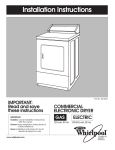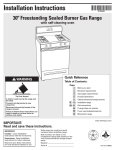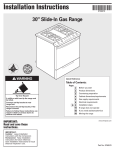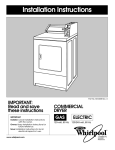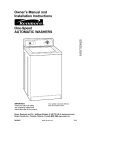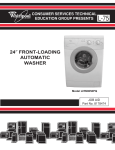Download Whirlpool LTG5243DQ0 Use & care guide
Transcript
Gas Thin Twin Washer•Dryer – 120 Volt Installation Instructions IMPORTANT: Installer: Leave Installation Instructions with the homeowner. Homeowner: Keep Installation Instructions for future reference. Save Installation Instructions for local electrical inspector’s use. Part No. 3405971 Rev. C Gas Thin Twin IMPORTANT: Read and save these instructions. When moving the washer/dryer... If washer/dryer does not operate properly... If you need assistance... • Disconnect the power supply cord, then tape securely to the washer/dryer. • Shut off the gas supply valve in the gas supply line. • Disconnect the flexible gas connector and fittings from gas supply line and cap the gas supply line. • Tape the flexible gas connector to back panel of the washer/dryer. DO NOT DISCONNECT THE FLEXIBLE GAS CONNECTOR FROM THE WASHER/DRYER. • Tape the dryer drum to the front panel. Tape the lint screen in place. Tape the dryer door closed. • Wedge a blanket between the tub ring and cabinet top to restrict tub movement. • Turn front leveling legs all the way in. Check the following to be sure that: 1. Electrical supply is connected. 2. House fuse is intact and tight or circuit breaker is not tripped. 3. Washer lid or dryer door is closed. 4. Round shipping piece has been completely removed. 5. Controls are set in a running or “ON” position. 6. Dryer start button has been firmly pushed. 7. Gas shutoff valve is open in supply line. Check your Use and Care Guide for a tollfree number to call, or call the dealer from whom you purchased this appliance. The dealer is listed in the Yellow Pages of your phone directory under “Appliances — Household — Major — Service and Repair.” When you call, you will need the washer/dryer model number and serial number. Both numbers can be found on the model/serial rating plate located on the door well behind the dryer door. Before installing the washer/dryer in your new home, check with your gas supplier or dealer to see that your dryer is equipped with the correct burner for the particular type of gas in your new home. Burner information may be found on the model/serial rating plate in the door well of the dryer. Part No. 3405971 Rev. C ©2001 Whirlpool Corporation Benton Harbor, Michigan 49022 Printed in U.S.A. Before you start... Your safety and the safety of others are very important. We have provided many important safety messages in this manual and on your appliance. Always read and obey all safety messages. This is the safety alert symbol. This symbol alerts you to potential hazards that can kill or hurt you and others. All safety messages will follow the safety alert symbol and either the word “DANGER” or “WARNING”. These words mean: Check location where washer/dryer will be installed. Proper installation is your responsibility. The washer/dryer must not be installed or stored in an area where it will be exposed to water and/or weather. Make sure you have everything necessary for correct installation. Grounded electrical outlet within 5 ft. of the center rear of cabinet is required. See “Electrical requirements,” Panel B. 1/8-inch NPT plugged tapping is required. See Panel B, Step K. rigid gas supply line DANGER You can be killed or seriously injured if you don’t immediately follow instructions. WARNING You can be killed or seriously injured if you don’t follow instructions. All safety messages will tell you what the potential hazard is, tell you how to reduce the chance of injury, and tell you what can happen if the instructions are not followed. Floor drain system requires a siphon break, Part No. 285320, available from your authorized parts distributor. Check code requirements: Some codes limit or do not permit installation of washer/dryer in garages, closets, mobile homes and sleeping quarters. Contact your local building inspector. Check utilities: Proper gas, water and electrical supply connections must be available. Check location where washer/dryer will be installed. Proper installation is your responsibility. The washer/dryer must not be installed or stored in an area where it will be exposed to water and/or weather. Make sure you have everything necessary for correct installation. gas shutoff valve Hot and cold water faucets: Must be within 4 feet of the back of the washer/dryer and provide water pressure of 5 -100 PSI. 1/8-inch NPT plugged tapping gas supply line coupling 38" min. to 41" max. from floor Standpipe drain system: Needs a two-inch diameter standpipe with minimum carryaway capacity of 17 gallons per minute. Top of standpipe must be at least 28 inches high and no higher than 48 inches from floor. Do Not store or operate washer/dryer below 32°F (some water may remain in washer). Proper operation of dryer cycles requires temperatures above 45°F. See Use & Care Guide for “Winterizing” information. Water heater: Set to deliver 140°F water to the washer. Laundry tub drain system: Needs a 20-gallon laundry tub. Top of tub must be at least 28 inches high and no higher than 48 inches from floor. If a longer drain hose is needed, Drain Hose, Part No. 388423, and Hose Connection Kit, Part No. 285442, are available from your authorized parts distributor. Dryer may be exhausted from the rear, left or right side. Exhausting through the side requires Exhaust Kit Part No. 279823. See “Exhaust requirements,” Panel C. Drain hose may also be installed to a laundry tub or floor drain system. See Panel F. Four-inch metal exhaust vent is required. SEE RECESSED AREA INSTRUCTIONS ON PANEL D. Level floor: 1-inch maximum slope under entire washer/dryer. Important: Observe all governing codes and ordinances. Support: Floor must be sturdy enough to support washer/dryer weight, with water and clothes, of 375 pounds. WARNING Explosion Hazard Keep flammable materials and vapors, such as gasoline, away from washer/dryer. Failure to do so can result in death, explosion, or fire. Location: Should be large enough to fully open dryer door to 90°. See Panel D for “Recessed and closet installation instructions” and “Product dimensions.” WARNING: For your safety the information in this manual must be followed to minimize the risk of fire or explosion or to prevent property damage, personal injury or death. — Do not store or use gasoline or other flammable vapors and liquids in the vicinity of this or any other appliance. — WHAT TO DO IF YOU SMELL GAS • Do not try to light any appliance. • Do not touch any electrical switch; do not use any phone in your building. • Clear the room, building or area of all occupants. • Immediately call your gas supplier from a neighbor’s phone. Follow the gas supplier’s instructions. • If you cannot reach your gas supplier, call the fire department. — Installation and service must be performed by a qualified installer, service agency or the gas supplier. Tools and materials needed for installation: level pliers Phillips screwdriver flat-blade screwdriver adjustable wrench (two may be required) utility knife safety glasses gloves slip-joint pliers (that open to 1-1/2" min.) diagonal cutters Panel A shutoff valve “open” position Gas supply requirements Electrical requirements to dryer WARNING WARNING gas supply line F. Explosion Hazard Use a new AGA or CSA approved gas supply line. Install a shut-off valve. Securely tighten all gas connections. If connected to LP, have a qualified person make sure gas pressure does not exceed 13" water column. Examples of a qualified person include licensed heating personnel, authorized gas company personnel, and authorized service personnel. Failure to do so can result in death, explosion, or fire. Observe all governing codes and ordinances. An individual manual shutoff valve must be installed within six (6) feet (1.8 m) of the dryer in accordance with the National Fuel Gas Code ANSI Z223.1*. This valve should be located in the same room as the washer/dryer and should be in a location that allows ease of opening and closing. Do Not block access to the shutoff valve. G. The dryer must be exhausted to the outside and provision made for enough combustion and ventilation air. Check governing codes and ordinances. Also refer to “Recessed and closet installations,” Panel D. H. This washer/dryer is equipped with its own permanent, flexible gas connector, design-certified by CSA International, for connecting the appliance to the gas supply line. A. This installation must conform with local codes, or in the absence of local codes, with the National Fuel Gas Code ANSI Z223.1/NFPA 54*. B. The design of this dryer has been certified by CSA International for use at altitudes up to 10,000 feet above sea level at the B.T.U. rating indicated on the model/serial rating plate. Burner input adjustments are not required when the dryer is operated up to this elevation. When installed above 10,000 feet, a four percent (4%) reduction of the burner B.T.U. rating shown on the model/serial rating plate is required for each 1,000 foot increase in elevation. For assistance when converting to other gas types and/or installing above 10,000 feet elevation, contact your local service company. C. Check that this dryer is equipped with the correct burner for the particular type of gas in the home. Burner information will be found on the model/serial rating plate in the door well of the appliance. If this information does not agree with the type of gas available, see your dealer. D. This dryer is equipped for use with NATURAL GAS. It is designed-certified by CSA International for L.P. (propane or butane) gases with appropriate conversion. No attempt shall be made to convert the appliance from the gas specified on the model/serial rating plate for use with a different gas without consulting the servicing gas supplier or your authorized service company. Conversion must be done by a qualified service technician. Gas conversion kit part numbers are listed on the gas valve burner bracket behind the access panel. (See Step 25, Panel G.) I. household rigid gas supply pipe If rigid pipe is used as a gas supply Use pipe-joint line, a combination compound. of pipe fittings must be used to obtain an in-line connection to Adapter supplied the washer/dryer. Do Not use pipe-joint compound. flexible gas connector J. For ease of installation, operating and servicing (if ever needed), adequate space should be provided around the washer/dryer. K. An 1/8-inch NPT plugged tapping, accessible for test gauge connection, must be installed immediately upstream of the gas supply connector to the dryer. The dryer must be disconnected from the gas supply piping system during any pressure testing of that system at test pressures in excess of 1/2 psig (3.45 kPa). Electrical Shock Hazard Plug into a grounded 3-prong outlet. Do not remove ground prong. Do not use an adapter. Do not use an extension cord. Failure to follow these instructions can result in death, fire, or electrical shock. Important: Observe all governing codes and ordinances. If codes permit and a separate ground wire is used, it is recommended that a qualified electrician determine that the ground path is adequate. A 120-volt, 60-Hz, AC-only, 15- or 20-ampere fused electrical supply is required. A timedelay fuse or circuit breaker is recommended. It is recommended that a separate circuit serving only this appliance be provided. Recommended ground method For your personal safety, this appliance must be grounded. This washer/dryer is equipped with a power supply cord having a 3-prong ground plug. To minimize possible shock hazard, the cord must be plugged into a mating, 3-prong, ground-type, wall receptacle, grounded in accordance with local codes, or in the absence of local codes, with the National Electrical Code, ANSI/NFPA 70**. If a mating wall receptacle is not available, it is the personal responsibility and obligation of the customer to have a properly grounded, 3-prong wall receptacle installed by a qualified electrician. WARNING - Improper connection of the equipment-grounding conductor can result in a risk of electric shock. Check with a qualified electrician or serviceman if you are in doubt as to whether the appliance is properly grounded. Do not modify the plug provided with the appliance – if it will not fit the outlet, have a proper outlet installed by a qualified electrician. 3-prong ground plug The dryer must be isolated from the gas supply piping system by closing its individual manual shutoff valve during any pressure testing of the gas supply piping system at test pressures equal to or less than 1/2 psig (3.45 kPa). power supply cord Provide a rigid gas supply line to the dryer location. When rigid pipe is used, it should be 1/2-inch IPS. When acceptable to the gas supplier and local codes, 3/8-inch approved tubing may be used for lengths under 20 feet. For lengths over 20 feet, larger tubing should be used. Pipe-joint compounds resistant to the action of L.P. gas must be used. Panel B ground prong Copies of the standards listed may be obtained from: * CSA International 8501 East Pleasant Valley Road Cleveland, Ohio 44131-5575 ** E. 3-prong ground-type wall receptacle National Fire Protection Association Batterymarch Park Quincy, Massachusetts 02269 Exhaust requirements WARNING better Fire Hazard Use a heavy metal vent. Do not use a plastic vent. Do not use a metal foil vent. Failure to follow these instructions can result in death or fire. Important: Observe all governing codes and ordinances. The dryer must be exhausted to the outdoors. Moisture and lint indoors may cause: • Lint to gather around the dryer where it can be fuel for a fire. • Moisture damage to woodwork, furniture, paint, wallpaper, carpet, etc. • Housecleaning problems and health problems. If the washer/dryer is installed in a confined area such as a bedroom, bathroom or closet, it must be exhausted to the outside and provisions must be made for enough air for ventilation. Check governing codes and ordinances. Also refer to the “Recessed and closet installation instructions” on Panel D. Four-inch heavy metal exhaust vent and clamps must be used. Dura Safe™ vent products are recommended. Dura Safe™ vent products can be purchased from your dealer or by calling Whirlpool Parts & Accessories 1-800-442-9991 (CST). Visit our internet site at http://whirlpoolappliances.com/accessories. Four-inch diameter vent must be used. Use a heavy metal vent. Do not use plastic or metal foil vent. • Do not use non-metal flexible vent, or exhaust hoods with magnetic latches. • Do not exhaust dryer into a chimney, furnace, cold air vent, duct, gas vent, wall, ceiling, concealed space, attic or crawl space, or any other vent used for venting. • Do not install flexible vent in enclosed walls, ceilings or floors. Rigid metal vent is recommended to prevent crushing and kinking. Flexible metal vent must be fully extended and supported when the dryer is in its final position. Remove excess flexible vent to avoid sagging and kinking that may result in reduced air flow. An exhaust hood should cap the exhaust vent to prevent rodents and insects from entering the home. Exhaust outlet hood must be at least 12 inches from the ground or any object that maybe in 12" the path of the exhaust minimum (such as flowers, rocks or bushes, etc.). If using an existing exhaust system, clean lint from entire length of system and make sure exhaust hood is not plugged with lint. Replace any plastic or metal foil vent with rigid metal or flexible metal vent. Use clamps to seal all joints. Do not use duct tape, screws or other fastening devices that extend into the interior of the vent to secure vent. Service check: Back pressure in any exhaust system used must not exceed 0.2 inches in water column measured with an incline manometer at the point that exhaust vent connects to dryer. The exhaust vent can be routed up, down, left, right or straight out of the back of the dryer. Space requirements are located on Panel D or on rear panel of the washer/dryer. Use the straightest path you can, to avoid 90° turns. Panel C Mobile home installation exhaust air flow This washer/dryer is suitable for mobile home installations. The installation of the washer/dryer must conform to the Manufactured Home Construction and Safety, Title 24 CFR, Part 3280 (formerly the Federal Standard for Mobile Homes Construction and Safety, Title 24, HUD Part 280, latest edition). good Plan installation to use the fewest number of elbows and turns. Maximum length of the exhaust system depends upon the type of vent used, number of elbows and the type of exhaust hood. The maximum length for both rigid and flexible vent is shown in the chart. NUMBER OF 90° TURNS 4" gas line Maximum length of 4" dia. vent. 4" outside wall 2-1/2" 0 1 2 3 43 ft 33 ft 23 ft 18 ft 41 ft 31 ft 21 ft 18 ft 0 1 2 3 30 ft 24 ft 16 ft 10 ft 29 ft 23 ft 15 ft 9 ft 36 ft 26 ft 16 ft rigid metal vent. Not recommended 24 ft 18 ft 10 ft flexible metal vent. Not recommended The maximum length using a 2" x 6" rectangular vent with 2 elbows and a 2-1/2" exhaust hood is 8 ft. For exhaust systems not covered by the exhaust length chart, see Service Manual, Part No. 603197, available from your authorized parts distributor. Four-inch outlet hood is preferred. However, a 2-1/2 inch outlet hood may be used with short systems only. A 2-1/2 inch outlet hood can result in longer drying times than other hood types. For permanent installation, a stationary exhaust system is required. Exhausting the dryer through the side of the washer/dryer requires the use of Side Exhaust Kit, Part No. 279823, available from your authorized parts distributor. Follow kit Installation Instructions for proper exhaust installation. floor enclosed area skirting For all installations, this appliance MUST be exhausted to the outside. Exhaust system hardware is available through your dealer. Mobile home exhaust requirements: The washer/dryer must have an outside exhaust. If the dryer is exhausted through the floor and the area under the mobile home is enclosed, the exhaust system must terminate outside the enclosed area. Extension beyond the enclosed area will prevent lint and moisture buildup under the mobile home. The exhaust vent must be securely fastened to a noncombustible portion of the mobile home structure. Do not use screws or other fastening devices that extend into the interior of the vent to secure the vent. Special provisions must be made in mobile homes to introduce outside air into the dryer. The opening (such as a nearby window) should be at least twice as large as the dryer exhaust opening. Recessed and closet installation instructions Product dimensions... (Shown with legs extended 1 inch from bottom of washer) Most installations will require at least 5 inch clearance behind the dryer for the dryer vent. Location must be large enough to fully open dryer door. This washer/dryer may be installed in a recessed area or closet. The installation spacing is in inches and is the minimum allowable. Additional spacing should be considered for ease of installation, servicing and compliance with local codes and ordinances. No other fuel-burning appliance shall be installed in the same closet as the washer/dryer. If closet door is installed, the minimum unobstructed air openings in top and bottom are required. Louvered doors with equivalent air openings are acceptable. Other installations must use the minimum dimensions indicated. 24" 12" 12" Now start... With washer/dryer in laundry area. WARNING Excessive Weight Hazard Use two or more people to move and install washer/dryer. Failure to do so can result in back or other injury. Truck only from rear to prevent product damage. 1. Put on safety glasses and gloves. Recessed installation 0" 0" 1-1/2" dryer exhaust outlet 38" 12" Remove cardboard shipping base. cold water inlet 28-5/8" drain outlet 27-1/2" 14-1/4" recess width 4-3/8" recess depth washer 2. 19" rear view front view 0" 15-3/8" rear legs 21-5/16" 1 drain hose clamp 27-5/8" front legs 1 small clamp 5-1/4" 57" side view Minimum installation spacing Additional clearance for wall, door and floor molding may be required. Additional space may be needed for exhaust elbow. 1 plastic beaded strap 71-3/4" 47" 3. 51-1/2" Remove parts from package. Check that all parts were included. 38" 32-1/8" 4. Insert a rear leveling leg into the hole in the rear corner. Push the leg in until it snaps into place. Do the same thing with the other leveling leg in the other rear corner. Closet installation WARNING - To reduce the risk of fire, this appliance MUST BE EXHAUSTED OUTDOORS. 27-1/4" 3" side view 48 sq. in.* 5. Push up on one leg. Check to see if the other leg goes down. Check the other leg in the same way. (If the legs do not adjust, repeat Step 4.) closet door 24 sq. in.* 3" 8. front view Unobstructed air openings are minimum for closet door. Louvered door with equivalent air openings is acceptable. 0" 48 sq. in.* 4. 5. 6. Additional space may be needed for exhaust closet door 4. 5. 24 sq. in.* 6. 1" side view Additional clearance for wall, door and floor molding may be required. * Opening is minimum for closet door. Louvered door with equivalent air openings is acceptable. Panel D 2. 7. 4 flat, water-hose washers Numbers correspond to steps. 12. 6. 16. Take hoses and package out of basket. Place hoses with other parts. With one of the legs in hand, check the ridges for a diamond marking. That’s how far the leg is supposed to go into the hole. Start to screw the legs into the holes by hand. Remove plug from drain connector. IMPORTANT: THIS PROCEDURE MUST BE FOLLOWED TO ASSURE PROPER INSTALLATION. 1/4" max. clamp latch 13. Use new hoses and washers that came with your washer/dryer. Replace inlet hoses after 5 years of use to reduce the risk of hose failure. Inspect and replace inlet hoses if bulges, kinks, cuts, wear, or leaks are found. When replacing your inlet hoses, mark the date of replacement on the label with a permanent marker. 7. Place a piece of cardboard or hardboard in front of carton. Stand the washer/dryer upright. 1/4" max. drain hose 17. Release washer lid by pushing up on latch. Close lid. Use slip-joint pliers to finish turning the front legs until you reach the diamond mark. Slide washer/dryer onto cardboard or hardboard before moving across floor to prevent damage to floor covering. drain connector To prevent the drain hose from coming off or leaking, it must be installed per the following instructions. 1. Wet the inside end of the drain hose with tap water. DO NOT USE ANY OTHER LUBRICANT. 2. Squeeze ears of small clamp with pliers to open clamp and place clamp over end of drain hose. 3. While holding clamp open, work end of drain hose onto drain connector. 4. Position clamp over the drain hose area marked “clamp.” Release clamp. Clamp should be 1/4 inch from end of drain hose. 18. coupling 14. washer Insert a flat washer into each end of the inlet hoses. Check that washers are firmly seated in couplings. To prevent product damage, Do Not remove corner posts inside the carton before cutting. cold Inlet valves are plastic. Do not overtighten or crossthread. Standpipe or laundry tub drain system: Open yellow clamp and slide over “hook” end of drain hose to secure the rigid and corrugated sections together. Floor drain system: Do Not install “hook” end of drain hose to corrugated section. Consult your plumber for proper installation. Slide washer/dryer onto cardboard or hardboard before moving across floor to avoid damaging floor. 8. With corner posts in place, cut carton down one corner. Remove carton. hot Do Not Remove. 15. 9. Remove the 2 rear corner posts from the back of the washer/dryer. Remove the two corner pieces attached to lower front of the washer/dryer. Do Not remove the foam shipping pieces between the washer and dryer until the washer/ dryer is in place. rear corner posts Attach hose to bottom (hot water) inlet valve opening first; then second hose to top (cold water) inlet valve. Tighten couplings by hand. Then use slip-joint pliers to make an additional two-thirds turn. lower front corner posts Numbers correspond to steps. 9. 10. 13. 12. latch 10. Move foam shipping pieces outward just enough to clear the washer lid. Open washer lid. The latch under the dryer will hold lid open. 11. round shipping piece Grasp round shipping piece at the front and the back. Lift to remove from inside washer. Panel E 11. 33. 9. 9. 26. 27. 28. Check that drain hose is not twisted or kinked and is securely in place. 33. A 31. 38. B 19. 25. 36. 29. 30. 14. 22. plastic beaded strap plastic beaded strap 23. Numbers correspond to steps. 16. 17. 14. 15. C plastic beaded strap 24. 18. 20. 24. 19. If you have room to work from either side of the washer/dryer, move washer/dryer close to final position so you can easily complete the following steps. Go to Step 20. If you are working in a closet or recessed area, move the washer/dryer into its final position and remove cardboard or hardboard from under washer/dryer. Remove the two foam shipping pieces. Remove the access panel by removing two Phillips-head screws, located at the top of the access panel. Set panel and screws aside. See Step 25, Panel G. Complete the following steps through the access area. 20. Put “hook” end of drain hose into laundry tub or standpipe. Check for proper length of drain hose. 21. Before attaching water inlet hoses, run water through both faucets into a bucket. This will get rid of particles in water lines that might clog hoses. Mark which is the hot water faucet. Replace inlet hoses after 5 years of use to reduce the risk of hose failure. Inspect and replace inlet hoses if bulges, kinks, cuts, wear, or leaks are found. When replacing your inlet hoses, mark the date of replacement on the label with a permanent marker. 23. Carefully move the washer/dryer into its final location. • Tilt the washer/dryer forward, raising back legs 1 inch off the floor so that the rear selfleveling legs will adjust. Gently lower the washer/dryer to the floor. • Check that the washer/dryer is level by placing a carpenter’s level on top of the washer, first side to side, then front to back. — If it is not level, adjust the front legs up or down. — Tilt the washer/dryer forward, raising back legs 1 inch off the floor so that the rear self-leveling legs will adjust. Gently lower the washer/dryer to the floor. — Check that the washer/dryer is level. Repeat as needed. Make sure the “hook” end of drain hose is in laundry tub or standpipe. Wrap the plastic beaded strap around the drain hose and laundry tub or standpipe. Thread beaded end of strap through keyhole end. Pull until strap is tight. Slide strap into narrow end of keyhole to lock strap in place. See Figures A and B. If the water inlet faucets and standpipe are recessed, tightly wrap the plastic beaded strap around the drain hose and faucet body. (Do Not wrap strap around the faucet handles or stems.) Thread beaded end of strap through keyhole end. Pull until strap is tight. Slide strap into narrow end of keyhole to lock strap in place. See Figure C. Secure the drain hose to the laundry tub or standpipe with the plastic strap. Failure to properly secure drain hose could result in water damage. If drain hose cannot be strapped into place, hose must be cut exactly to length so “hook” end is held tightly over edge of laundry tub or standpipe. D See Figure D. If a longer drain hose is needed, Drain Hose, Part No. 388423 and Hose Connection Kit, Part No. 285442 are available from your authorized parts distributor. If drain hose must be shortened, use Hose Connection Kit, Part No. 285442. Note: If washer/dryer is moved to adjust drain hose, the washer/dryer must be leveled again. Repeat Step 23. Place cardboard under the washer/dryer and carefully move washer/dryer to avoid damaging floor covering. 22. Attach bottom hose (inlet marked “H”) to hot water faucet. Attach top hose (inlet marked “C”) to cold water faucet. Tighten the coupling to the faucet by hand. Use pliers to make final two-thirds turn. Move washer/dryer close to its permanent location. Remove cardboard/hardboard from under washer/dryer. Numbers correspond to steps. 19. 25. access panel wiring diagram Panel F 25. shutoff valve “open” position If you did not remove the access panel in Step 19, remove the two foam shipping pieces between the washer and dryer and place with other shipping pieces. Remove the two Phillipshead screws located at the top of the access panel. Set panel and screws aside. 33. to dryer gas supply line 27. All connections must be wrenchtightened. Open the shutoff valve in the gas supply line. Check that you removed all the shipping pieces including the round shipping piece. Dispose of all materials in proper manner. If you do not remove the round shipping piece, your washer/dryer may “walk” away from its location. 28. conversion kit part nos. open position access panel wiring diagram The wiring diagram is located on the back of the access panel. Read before installing or servicing. Use a brush and liquid detergent to test all gas connections for leaks. Bubbles around connections will indicate a leak. If a leak appears, shut off gas valve controls and adjust connections. Then check connections again. level Phillips screwdriver 29. Determine the length of exhaust vent that is needed to connect the dryer to the exhaust hood. See “Exhaust requirements,” Panel C. diagonal cutters utility knife adapter flat-blade screwdriver Remove the red cap from the flexible gas connector. Remove the adapter from the flexible gas connector. (It may be necessary to use two adjustable wrenches.) Install the adapter on the rigid gas supply line using pipe-joint compound. Attach the flexible gas connector to the adapter. Do Not use pipe-joint compound. See Step I, Panel B. Connect dryer to rigid gas supply line so that there is a natural loop in the flexible gas connector from the dryer. The couplings should be in the same plane and positioned just far enough apart to allow the flexible gas connector from the dryer to loop without any strains on the line. The flexible gas connector must NOT be twisted, kinked or attached with any sharp bends. Use pipe-joint compound resistant to the action of L.P. gas for all gas connections, except at the flexible gas connector to the adapter. See Step I, Panel B. A rigid gas supply line to washer/dryer location must be used. 30. Connect exhaust vent to washer/dryer and then to the exhaust hood. • Use the straightest path possible to avoid 90° turns. • Use clamps to seal all joints in the exhaust system. • Use caulking compound to seal exterior wall opening around exhaust hood. 31. CHECK ELECTRICAL REQUIREMENTS. BE SURE YOU HAVE CORRECT ELECTRICAL SUPPLY AND RECOMMENDED GROUND METHOD. Check the Installation Instructions to see that you have completed each step. Complete any missed steps before you continue. Panel G Check that you have all of your tools. Turn on water faucets and check for leaks. Tighten couplings if there is leaking. DO NOT OVERTIGHTEN; this could cause damage to faucets. 36. Replace access panel. Be sure to tighten the two Phillips-head screws at the top of the access panel. Plug power supply cord into grounded outlet. Now start the washer and allow it to complete the regular cycle. 39. 32. Placing the couplings too close together causes double bends that may result in fatigue failure of the fittings. 34. 35. 38. Gas supply line coupling should be 38 inches min. to 41 inches max. from floor and against (parallel to) wall. A sharp bend in the flexible gas connector at the couplings causes straining and twisting, which may result in premature failure of the connector. safety glasses 37. The flexible gas connector MUST be connected in a single, natural loop. DO NOT OFFSET COUPLINGS — this causes twisting and straining of the flexible gas connector, which may cause premature failure of the connector. pliers Read the Use and Care Guide to fully understand your new washer/dryer. Open dryer door. Check to be sure lint screen is in its proper position. Wipe out drum with damp cloth to remove any dust. Right method Wrong methods gloves clamp red cap 26. adjustable wrench (two may be required) slip-joint pliers Check that all parts are now installed. See parts list, Step 3, Panel D. If there is an extra part, go back through steps to see which step was skipped. Start dryer to remove air from the gas supply line. Using a full heat cycle (not the air cycle), let the dryer run for at least five minutes. If the burner does not ignite and you do not feel heat inside the dryer, shut off the dryer for five minutes. Check that all gas supply valve controls are in the “ON” position and that the power supply cord is plugged in. Repeat the five-minute test. You have successfully installed your new washer/dryer. To get the most efficient use from your new washer/dryer, read your Use and Care Guide. Congratulations! Keep Installation Instructions nearby where you can refer to them. They’ll make reinstalling your washer/dryer in another home as easy as the first installation. Gas Thin Twin Washer•Dryer – 120 Volt Installation Instructions IMPORTANT: Installer: Leave Installation Instructions with the homeowner. Homeowner: Keep Installation Instructions for future reference. Save Installation Instructions for local electrical inspector’s use. Part No. 3405971 Rev. C Gas Thin Twin IMPORTANT: Read and save these instructions. When moving the washer/dryer... If washer/dryer does not operate properly... If you need assistance... • Disconnect the power supply cord, then tape securely to the washer/dryer. • Shut off the gas supply valve in the gas supply line. • Disconnect the flexible gas connector and fittings from gas supply line and cap the gas supply line. • Tape the flexible gas connector to back panel of the washer/dryer. DO NOT DISCONNECT THE FLEXIBLE GAS CONNECTOR FROM THE WASHER/DRYER. • Tape the dryer drum to the front panel. Tape the lint screen in place. Tape the dryer door closed. • Wedge a blanket between the tub ring and cabinet top to restrict tub movement. • Turn front leveling legs all the way in. Check the following to be sure that: 1. Electrical supply is connected. 2. House fuse is intact and tight or circuit breaker is not tripped. 3. Washer lid or dryer door is closed. 4. Round shipping piece has been completely removed. 5. Controls are set in a running or “ON” position. 6. Dryer start button has been firmly pushed. 7. Gas shutoff valve is open in supply line. Check your Use and Care Guide for a tollfree number to call, or call the dealer from whom you purchased this appliance. The dealer is listed in the Yellow Pages of your phone directory under “Appliances — Household — Major — Service and Repair.” When you call, you will need the washer/dryer model number and serial number. Both numbers can be found on the model/serial rating plate located on the door well behind the dryer door. Before installing the washer/dryer in your new home, check with your gas supplier or dealer to see that your dryer is equipped with the correct burner for the particular type of gas in your new home. Burner information may be found on the model/serial rating plate in the door well of the dryer. Part No. 3405971 Rev. C ©2001 Whirlpool Corporation Benton Harbor, Michigan 49022 Printed in U.S.A.









